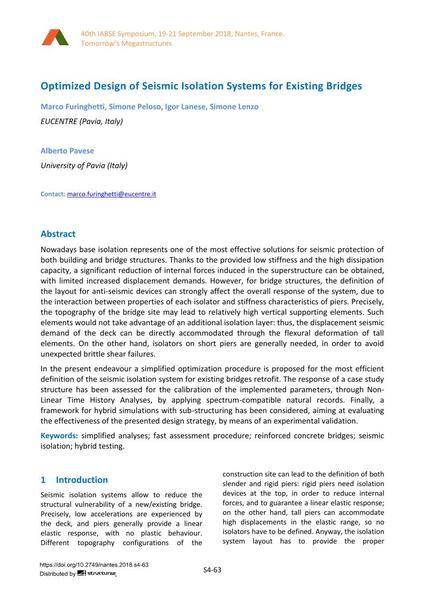Optimized Design of Seismic Isolation Systems for Existing Bridges

|
|
|||||||||||
Détails bibliographiques
| Auteur(s): |
Marco Furinghetti
(EUCENTRE (Pavia, Italy))
Simone Peloso (EUCENTRE (Pavia, Italy)) Igor Lanese (EUCENTRE (Pavia, Italy)) Simone Lenzo (EUCENTRE (Pavia, Italy)) Alberto Pavese (University of Pavia (Italy)) |
||||
|---|---|---|---|---|---|
| Médium: | papier de conférence | ||||
| Langue(s): | anglais | ||||
| Conférence: | IABSE Symposium: Tomorrow’s Megastructures, Nantes, France, 19-21 September 2018 | ||||
| Publié dans: | IABSE Symposium Nantes 2018 | ||||
|
|||||
| Page(s): | S4-63 | ||||
| Nombre total de pages (du PDF): | 8 | ||||
| DOI: | 10.2749/nantes.2018.s4-63 | ||||
| Abstrait: |
Nowadays base isolation represents one of the most effective solutions for seismic protection of both building and bridge structures. Thanks to the provided low stiffness and the high dissipation capacity, a significant reduction of internal forces induced in the superstructure can be obtained, with limited increased displacement demands. However, for bridge structures, the definition of the layout for anti-seismic devices can strongly affect the overall response of the system, due to the interaction between properties of each isolator and stiffness characteristics of piers. Precisely, the topography of the bridge site may lead to relatively high vertical supporting elements. Such elements would not take advantage of an additional isolation layer: thus, the displacement seismic demand of the deck can be directly accommodated through the flexural deformation of tall elements. On the other hand, isolators on short piers are generally needed, in order to avoid unexpected brittle shear failures. In the present endeavour a simplified optimization procedure is proposed for the most efficient definition of the seismic isolation system for existing bridges retrofit. The response of a case study structure has been assessed for the calibration of the implemented parameters, through Non- Linear Time History Analyses, by applying spectrum-compatible natural records. Finally, a framework for hybrid simulations with sub-structuring has been considered, aiming at evaluating the effectiveness of the presented design strategy, by means of an experimental validation. |
||||
